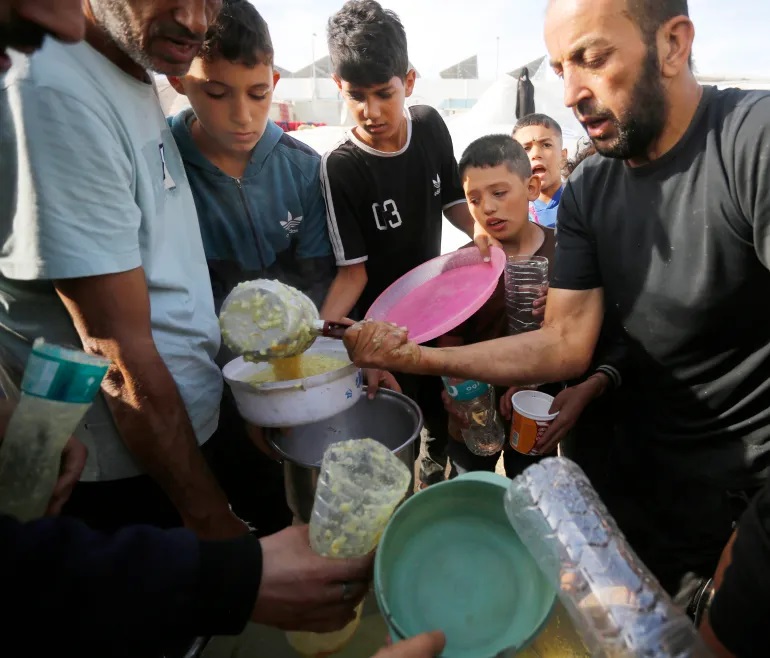Gaza’s Soup Kitchens on the Brink of Closure as Israeli Siege Chokes Food Supplies
With humanitarian aid blocked, Gaza’s makeshift soup kitchens struggle to feed thousands as child malnutrition cases soar and families battle starvation.

Watan-After a long wait in a massive crowd outside a soup kitchen located in the center of Al-Nuseirat refugee camp in central Gaza, 13-year-old Ahmad Abdel Karim returned home with only a small portion of hot food prepared by a relief organization.
Ahmad, like many other children, rushed back to his family at a nearby shelter, where everyone was anxiously waiting to break their fast. It was nearly noon, and none of them had eaten a single piece of bread.
He told Al-Quds Al-Arabi that he now goes daily to the “takia” (charitable soup kitchen), bringing a metal pot, and often waits over two hours to receive food.
Ahmad added that the crowding frequently means he gets a small amount of food—or spills some of it during the pushing.

Before the war, Ahmad and his peers had never heard of a “takia”—a word that evokes memories of the 1948 Nakba, when Palestinians were violently displaced by Zionist militias.
Now, soup kitchens have become the primary food source for residents across Gaza’s remaining areas not yet subject to forced evacuation orders, due to the depletion of regular food supplies.
These kitchens rely on local and international donations, cooking over wood-fired stoves. Despite the food’s simple nature, people have come to depend on it out of economic desperation.
Nada, a woman who lost her husband in the war, told Al-Quds Al-Arabi: “Luxury is no longer an option—feeding the children is what matters now.”
She added that meals are mostly limited to pasta, rice, and lentils—without any meat.
With tears in her eyes, Nada recalled coming home empty-handed on some days. Videos show children scraping leftovers from cooking pots—or even the ground.

Since the start of the siege, Israeli authorities have blocked the entry of food, medicine, and fuel into Gaza. This has caused the collapse of UN aid operations, with UNRWA recently announcing it had run out of flour and food parcels, and the World Food Programme distributing its last stocks to the remaining soup kitchens.
The UN Office for the Coordination of Humanitarian Affairs (OCHA) stated that 16 more kitchens have shut down due to lack of supplies, warning of worsening hunger levels.
Ibrahim Al-Tahrawi, who runs a kitchen in western Khan Younis, said food stocks are barely enough for a few days. His team once operated several kitchens in Rafah and Khan Younis, but most have now closed due to funding shortages.
To cope, aid teams have had to reduce daily food quantities to prolong their operations.
OCHA reports around 10,000 cases of acute malnutrition among children, including 1,600 cases of severe wasting. Humanitarian access to treatment in southern Gaza remains extremely limited due to operational and security challenges.
In condemning the siege, UNRWA Commissioner-General Philippe Lazzarini said, “Famine in Gaza is man-made and politically driven.”
With prices skyrocketing, flour now sells at 30 shekels per kilo ($8.28), potatoes at 60 shekels ($16.60), and tomatoes at 30 shekels ($8.28).
To survive, Wafa Saadi mixes flour with pasta to make bread. She told Al-Quds Al-Arabi: “There’s nothing left to eat.”
She added that her young daughter’s weight has dropped drastically due to severe malnutrition.
According to Gaza’s Government Media Office, over 65,000 children and infants are now suffering from acute malnutrition out of 1.1 million children enduring daily hunger.






